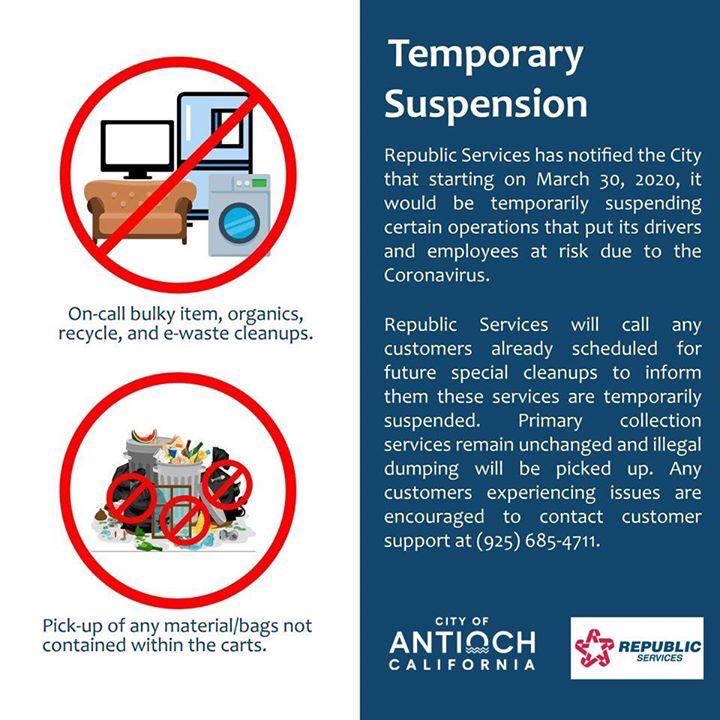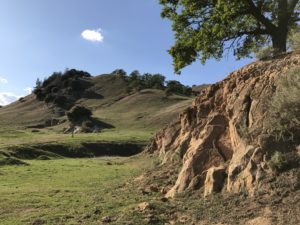Antioch Council adopts moratorium on evictions in Antioch, gives renters 90 days to reimburse landlord for each month of non-payment
Tuesday, March 31st, 2020Applies to both residential and commercial properties
By Allen Payton
In response to the shelther in place due to the coronavirus/COVID-19 pandemic, during their special meeting on Tuesday, March 31, 2020, the Antioch City Council adopted a moratorium banning evictions for residential and business property through May 31, 2020 and giving tenants who are unable to pay 90 days to catch up on their rent for each month they’re in arrears. ACC2020.03.31 – URGENCY ORDINANCE – Moratorium on Evictions
According to City Attorney Thomas Smith, the difference between this ordinance and the governor’s executive order is that the city’s gives renters six months to reimburse their landlord.
Following public comments, Councilman Lamar Thorpe was the first council member to share his thoughts.
“I just want to ask the city attorney what differentiates what we’re doing versus what the state has done,” he said.
“This is also addressing business,” said City Attorney Thomas Smith. “This pandemic is having an impact beyond residents.”
“There is a loss of demand out there because everyone is staying home,” he continued. “Only people who are providing essential things…people are going to online entities. This also addresses the commercial impact. Employees need someplace to go back to when this pandemic is over.”
“The governor gave seven days after the person can’t pay rent to inform the landlord,” Smith continued. “This gives 14 days.”
“It’s overall a broader ordinance…including six months in order to pay back their rent,” he concluded.
“We’re including commercial, we’re thinking about the small business owner, and we’re extending to 14 days,” Thorpe said.
“And giving six months to pay their rent.” Smith added.
“Can you give the rationale…this time period after your rent is due,” Thorpe asked.
“One of the things we know is, COVID-19 is potentially a killer,” Smith responded. “If you’re sick with it, it can and will completely, in some cases, shut you down. If you’re in need of intensive care, it’s safe to assume you’re not focused on ‘oh, I missed my rent.’ So, it gives people some breaks. There literally is some grace periods…is something we’re offering recognizing the seriousness, if it’s a COVID-related impact.”
“The only final thought I’ll add is, the way we framed this urgency ordinance…as we think about, I think the scope to me is still too narrow,” Thorpe stated. “I strongly urge we consider focus on moratorium on evictions during the coronavirus/COVID-19 emergency.”
Councilwoman Monica Wilson asked that an email from a resident was read.
“In regards to the unpaid rent, can we…change the line to ‘120-day grace period per month’,” she asked.
“The 14-day grace period is the front end, and then on the back end is the six months after the expiration of the ordinance,” Smith said. “Six months is longer than 120 days.”
“Per month of missed rent,” Wilson reiterated.
“What this says, the tenant must pay within six months,” Smith explained.
“It’s giving them up to a year for repayment,” Wilson said.
“What Councilmember Wilson is saying, if it’s two months, it would be 240 days, which would be eight months,” Mayor Sean Wright explained.
“Hmmm. That’s interesting,” Smith said.
“I believe other cities are doing this,” Wilson said.
“Concord has a 90-day grace period,” Smith responded.
“If it ends May 31, it would be two months,” Wright said.
“Ours doesn’t necessarily end May 31st,” Smith responded. “It’s within your discretion…”
“I’m adding this and wondering if members on this council…” Wilson started to say.
“Councilwoman Wilson’s idea, I like that idea,” Thorpe stated.
“The 90 days kind of mirrors Concord’s,” Wright said.
Mayor Pro Tem Motts then said, “I think it’s kind of absurd that people who are going to be without income for two or three months, they’re going to be able to repay in two or three months. I think we’re setting them up for failure. I understand what the landlord is saying.”
“Nothing in here prohibits landlords or tenants from making other arrangements,” she said. “I like, Monica what you had to say, here.”
“I agree with Councilman Thorpe’s comments…the language should be ‘during the COVID-19 emergency’,” she stated. “I want our businesses to be comfortable that they scan stay in business.”
Councilmember Lori Ogorchock asked what the other council members meant by their comments.
Wright explained that the ordinance includes six months from May 31st but the other councilmembers are suggesting 120 days per month for renters to pay their back rent.
“I don’t know if I’m in agreement with that,” Ogorchock said. “I have received calls. Some of these rentals are the only income some of these people have. You’re taking salaries and income away from other people who rely on these funds. If you’re going to give them a year to repay, it will make it hard for them.”
“Some landlords have sent out letters to their tenants, including commercial tenants, giving them time to repay,” she continued. “I think going beyond these timeframes would make it difficult for these landlords.”
“Landlords are free to work out whatever they want,” Thorpe said. “This just sets a framework…a process that says this is the way it will work out.”
“Part of what it does is strengthen the bargaining position of the tenant,” Smith said. “It gives a baseline, as you said. At a minimum what we saying to businesses is we’re supporting them.”
“These are unprecedented times,” Wright said. “Never before has government told the public 80% of them can’t go to work. So, government, I believe should stay out of these kinds of things. Over 50% of our residents are paycheck to paycheck. I think this is something we have to do. The moratorium, I’m fine with it being until May 31st or until this ends.”
“The problem is the landlord, I spoke to my bank, they give me three months of forebearance,” he continued. “But at the end of those 90 days I owe every bit of it.”
“I think the 90 days, it gives the tenant six months if it goes a third month, it extends another 90 days. I know it’s hard for the landlords,” Wright continued. “But they’re going to have to work with their mortgage holder.”
Change the moratorium to urgency for COVID-19
“Going back to what I was saying about the owners of these properties, it’s not going to do the renters any good if the owners lose their properties,” Ogorchock stated. “We have to be very careful what we’re doing.”
Wright reopened public comment.
Several comments asked the council to also consider a moratorium on rent increases, as well.
Others requested that no late fees be added to rents that can’t be paid on time.
Another comment asked the council to reduce the requirements for paystubs, etc. to prove the hardship.
Motts then asked that language be include for tenants who can’t provide documentation, that they provide written notification to the landlord, instead.
“So, the words that are used, they tend to be specific to align the ordinance with the executive order,” Smith explained. “When you look at the Concord ordinance, they use the word documentation. These words are aligned legally with the words in the executive orders. Notification is different than documentation. It’s not the standard if you have to go to court.”
“Being in line with other cities as a group…is important for us as a city…as a legal defense strategy,” he explained. “And to stay under the umbrella of the state executive order.”
“Other form of objective proof is included in the language,” he continued.
“In relation to the period of time, we do either what Concord did and go with the 90 days or go with the six months,” Smith stated. “I rarely jump in and urge you to do something.”
“What I don’t want to be is in a position that is legally hard to defend,” he said.
Thorpe reiterated his concern from earlier, that the ordinance was too narrowly written and that the language should be more broad to include anyone affected by the COVID-19
“We can pass this as is,” but I’d really like to time to look into the wording to expand the scope,” Smith said. “There has to be a causal relationship in my mind. Can we show that there is a causal relationship in the definition that you’re proposing?
“It is not a presumption. We’ve asked people to stay home,” Thorpe responded.
“Certain people,” Smith interjected.
“We are telling people to stay home,” Thorpe said. “It would just be an urgency ordinance…during the coronavirus/COVID-19 emergency. Right now, we’re limiting it to rent and loss of income.
“Some people are still working. So the connection between loss of income and inability to pay rent..if you’re income is not affected then you should pay your rent,” Smith said.
“Whether you’re essential or non-essential, if you’re the worst tenant in the world, this is not the time to evict someone. It would be contrary to evict someone during the shelter in place order,”
“So, you want no landlord to evict anyone during the coronavirus,” Smith asked.
“Why would we want anyone to move when we’re asking people to shelter in place?” Thorpe asked.
“We are under the shelter of the state order,” Smith responded. “When we say no one can evict anyone during this time, that is no under the shelter of the state order. That is not under our police power. If we’re going to do something like that, we better be sure.”
“If you need to do more work, that’s fine,” Thorpe said. “We don’t want more people in shelters.”
“I just want to look whether or not we can do that,” Smith responded.
“I hear you,” Thorpe concluded.
“Right now evictions are on a stay, there can be no evictions, the courts are closed,” Ogorchock stated. “There’s a stay on foreclosures. Again, talking to Realtors…they’re unable to any evictions, right now. There is a stay on foreclosures at this time.”
“The fact the courts are closed is operational,” Smith pointed out. “When the courts open back up, if we make the change, then we would be under our authority on that.”
“I understand and see where Councilman Thorpe is coming from,” Wilson said. “I just want to make sure people have time to make up their rent.”
“I’m comfortable with either one of them. The 90 days like Concord,” Smith reiterated.
“I just wanted to reiterate what Councilmember Wilson said,” Motts stated. “I think if we’re expecting people to immediately pay back their rent we’re setting them up for failure. We don’t want more homeless.”
“Can we make these changes, tonight?” she asked.
“You can make the changes tonight, but this is an urgency ordinance which requires a 4/5ths vote,” Smith said. “It will go into effect, tonight.”
“I’m just in a position that we don’t go outside of
“A landlord can still file an eviction…yes, it can, Lori, you can shake your head all you want,” Thorpe said. “It can sit in a pile and when the courts open up…their processes are their processes.
“Roll your eyes all you want, Lori,” he added with a laugh.
“This ordinance has to do with during the emergency of the COVID-19,” Motts said. “So, I’m comfortable with that language.”
Smith said he would go back and look at additional language at Thorpe’s request.
Thorpe agreed and made the motion to adopt, with the change to the language to include a 90-day grace period per month of arrears after the expiration or termination of this ordinance, using the language from the Concord ordinance.
Wilson seconded the motion.
Ogorchock, “When Lamar was saying his motion, Smith was striking something out, so can you please read the entire language?”
Smith re-read the proposed language for the ordinance with the requested changes.
The motion passed on a 5-0 vote.
Moratorium On Rent Increases and Fees
The council members then discussed a moratorium on rent increases and fees asking the City Attorney to return with an ordinance for them to vote on at their next meeting
City Manage Ron Bernal explained that the item was in response to a request by Thorpe at the previous council meeting. There was no staff report included with the agenda.
“I’m happy to encourage our city attorney to go back and develop language for an ordinance,” Thorpe said.
Wright shared that a landlord is requiring tenants to pay a $46 fee for using their debit card to pay their rent, even though he won’t allow payment by check. “That’s wrong,” he said.
“I, too got that same email about the $46 fee,” Wilson said. She was in agreement.
“The last thing we want to do is make the situation worse,” Motts stated. “It makes no sense to have all these increases or additional fees. I’m in support for Thomas to look into this.”
“I see this as the exact opposite, in talking with brokers, today,” Ogorchock said. “They’re offering a reduction in rent. I did not see the $46 email. I’m seeing the exact opposite.”
“If there’s something we can do…we should help,” Wright said. “I’m seeing a consensus to bring this back.”
With that the council voted to adjourn the meeting.
ORDINANCE FINAL ADOPTED LANGUAGE
Following is the actual language in the ordinance adopted Tuesday night:
Section 3. Moratorium on Eviction for Nonpayment of Rent during the COVID-19 Emergency.
- During the term of this Ordinance, no landlord shall endeavor to evict a residential or commercial tenant for nonpayment of rent, including but not limited to any such action under Civil Code sections 1940 et seq. or 1954.25 et seq., if the tenant provides written documentation or other objectively verifiable proof evidencing the following:
- The tenant’s inability to pay rent is was caused by, or arises out of, a substantial decrease in household or business income (including but not limited to the circumstances described in subsections B or C) or substantial out-of-pocket medical expenses; and
- The decrease in household income, or out-of-pocket medical expenses, was caused by the COVID-19 pandemic, or by any local, state, or federal government response to COVID-19.
- “Substantial decrease in household income” includes but is not limited to loss of income caused by COVID-19 illness or caring for a household or family member with COVID-19 illness, work closures, layoffs, job loss, a reduction in the number of compensable hours or other economic or employer impacts of COVID-19, including missing work due to a minor child’s school closure, compliance with government health authority orders, or a similarly-caused reason resulting in loss of household income due to COVID-19, that is substantiated with written documentation.
- “Substantial decrease in business income” includes, but is not limited to, loss of income caused by work closures, reduction in staff reporting to work, reduction in opening hours, or reduction in consumer demand, compliance with government health authority orders, or other similarly caused reason resulting in loss of business income due to COVID-19, substantiated with written documentation or other objectively verifiable proof of same.
- A landlord that knows that a tenant cannot pay some or all of the rent temporarily for the reasons set forth above shall not serve a notice pursuant to Civil Code of Procedure section 1161, file or prosecute an unlawful detainer action based on a three-day pay or quit notice, or otherwise seek to evict for nonpayment of rent.
- The City encourages tenants to inform landlords in writing of their inability to pay full rent as soon as practicable after they become aware of a substantial decrease in household income or business income or out-of-pocket medical expenses that would prevent them from paying full rent. A landlord knows of a tenant’s inability to pay rent within the meaning of this Ordinance if the tenant, within 14 days after the date that rent is due, notifies the landlord in writing of the tenant’s inability to pay the full rent because a substantial decrease in household or business income or the need to pay out-of-pocket medical expenses was caused by the COVID-19 pandemic, or by any local, state, or federal government response to COVID-19, and provides documentation to support the claim. Any medical or financial information provided to the landlord shall be held in confidence, and only used for evaluating the tenant’s claim. For purposes of this Ordinance, “in writing” includes email or text communications to a landlord or the landlord’s representative with whom the tenant has previously corresponded by email or text.
- Nothing in this Ordinance relieves the tenant of liability for the unpaid rent, which the landlord may seek after the expiration of this Ordinance, affected residential and affected commercial tenants shall receive a ninety (90) day grace period per month of arrears after expiration or other termination of the term of this Ordinance during which to repay any monies due to a landlord for failure to pay rent or utilities, unless a state law or order is amended or adopted providing for a longer repayment period, in which case the payment period provided by the state law or order shall apply under this Ordinance.
- A landlord may not charge or collect a late fee or any other new fees for rent that is delayed for the reasons stated in this Ordinance, nor may a landlord seek rent that is delayed for the reasons stated in this Ordinance through the eviction process.
- This Ordinance may be asserted as an affirmative defense in any unlawful detainer action or other action brought by an owner or landlord to recover possession. A tenant may bring a civil suit seeking owner or landlord compliance with any provisions of this Ordinance.
- This Ordinance applies to nonpayment eviction notices and unlawful detainer actions based on such notices, served or filed on or after March 16, 2020 and until the expiration of this Ordinance, as set forth in Section 7, below.
- Courts shall have the sole discretion to determine in an unlawful detainer action or other eviction action whether the tenant’s written notice and documentation are sufficient to show a “substantial decrease in household” or “substantial out-of-pocket medical expenses.”
Section 4. Moratorium on Judicial Foreclosures during the COVID-19 Emergency.
As provided for in Executive Order N-28-20 and consistent with the other provisions in this Ordinance, the statutory cause of action for judicial foreclosure, Code of Civil Procedure section 725a et seq.; the statutory cause of action for unlawful detainer, Code of Civil Procedure section 1161 et seq.; and any other statutory cause of action that could be used to evict or otherwise eject a residential or commercial tenant or occupant of residential real property after foreclosure is hereby suspended as applied to any tenancy, or residential real property and any occupation thereof, to which a limitation on eviction is imposed pursuant to this Ordinance.
Section 5. Compliance with the California Environmental Quality Act.
The City Council hereby finds approval of this Ordinance is exempt from the California Environmental Quality Act (Public Resources Code §§ 21000et seq., “CEQA,” and 14 Cal. Code Reg. §§ 15000 et seq., “CEQA Guidelines”) under Section 15061(b)(3) of the CEQA Guidelines.
Section 6. Severability.
If any section, subsection, sentence, clause or phrase of this chapter is for any reason held to be invalid or unconstitutional by a decision of any court of competent jurisdiction, such decision shall not affect the validity of the remaining portions of this chapter. The City Council hereby declares that it would have passed the ordinance codified in this chapter, and each and every section, subsection, sentence, clause or phrase not declared invalid or unconstitutional without regard to whether any portion of this chapter would be subsequently declared invalid or unconstitutional.
Section 7. Effective Date and Publication.
This Urgency Ordinance shall become effective immediately upon its adoption by not less than a four-fifths vote of the Antioch City Council pursuant to California Government Code Section 36937 and shall remain in effect until May 31, 2020 or the expiration of the local emergency or the Governor’s proclamation of a state of emergency, whichever is later. Prior to the expiration of fifteen days from the passage thereof, the ordinance or a summary thereof shall be posted or published as may be required by law.

















 Also, check our website before you go to see updates on any closures. Be sure to “go” before you go and wash your hands before and after your visit a park or trail. Bring hand sanitizer if you have it.
Also, check our website before you go to see updates on any closures. Be sure to “go” before you go and wash your hands before and after your visit a park or trail. Bring hand sanitizer if you have it. By Don Amador
By Don Amador












